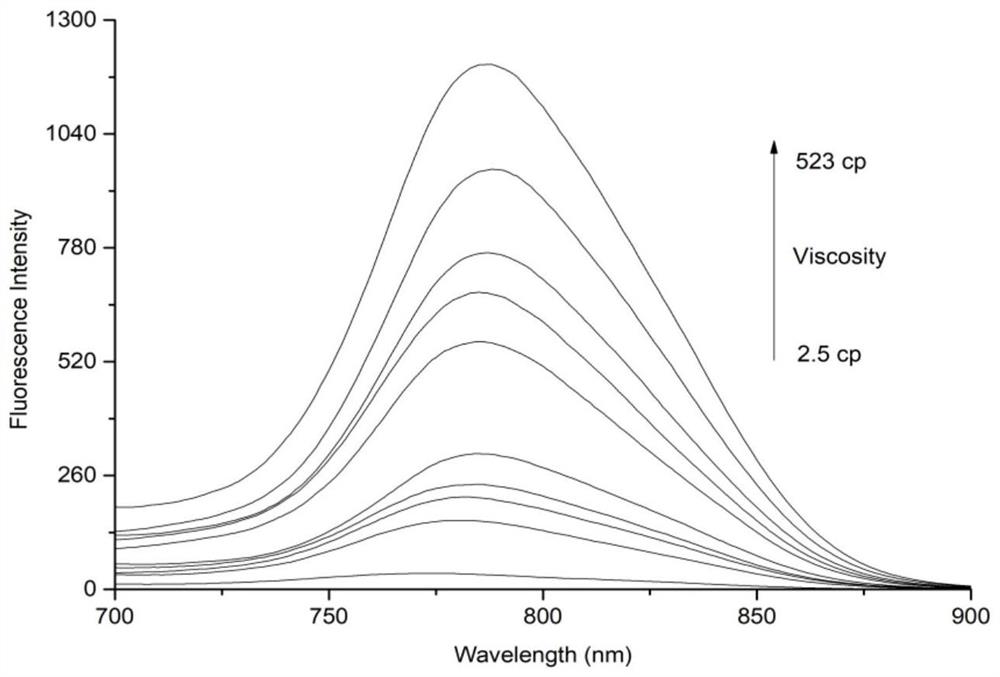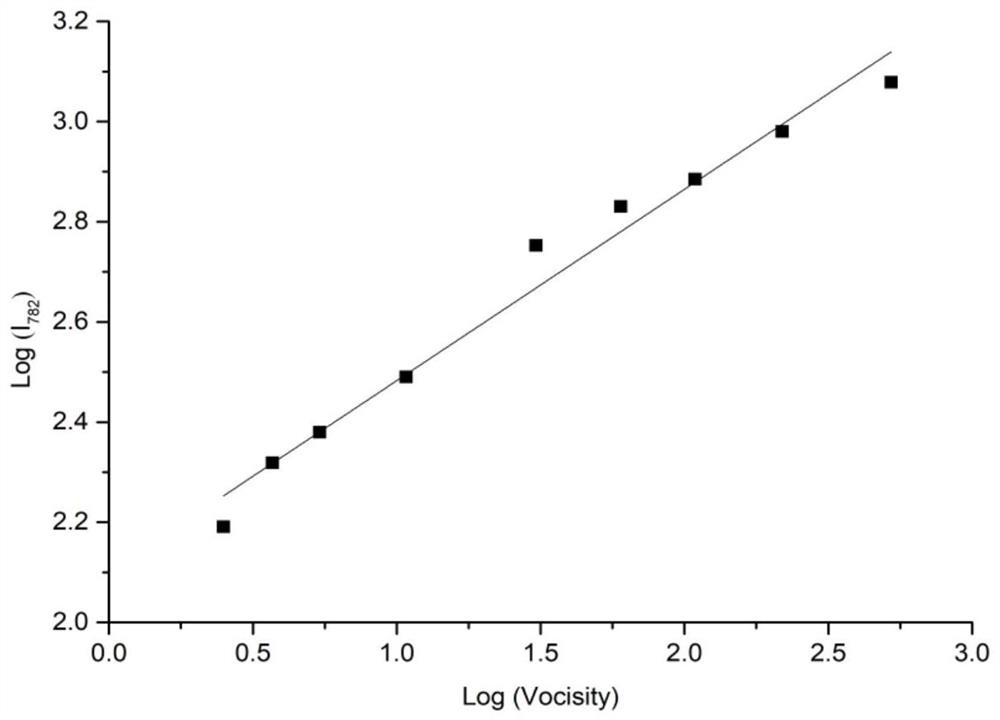Preparation and application of viscosity near-infrared fluorescent probe
A fluorescent probe and near-infrared technology, applied in the field of fluorescent probes, can solve problems such as viscosity detection
- Summary
- Abstract
- Description
- Claims
- Application Information
AI Technical Summary
Problems solved by technology
Method used
Image
Examples
Embodiment 1
[0027] Synthesis of Fluorescent Probes
[0028] Synthetic routes such as figure 1 . In a 25 mL round-bottom flask, 2-methyl-N-ethylquinoline (204 mg, 1.2 mmol) and diethylaminoxanthene (285 mg, 1 mmol) were dissolved in 10 mL of EtOH, purged with nitrogen, and evacuated . Under stirring conditions, 0.3 mL of piperidine was added, and the mixture was refluxed in an oil bath at 80 °C for 16 h. After completion of the reaction, the solvent was evaporated under reduced pressure. The obtained crude product was purified by column chromatography (dichloromethane:methanol=100:3) to obtain a blue solid QX-V, which was the fluorescent probe. (263 mg, 60% yield). 1 H NMR (400MHz, CDCl 3 ):δ8.63(d,J=9.4Hz,1H),8.56(d,J=9.3Hz,1H),8.52(d,J=14.2Hz,1H),7.81(d,J=8.0Hz,1H) ),7.78(d,J=8.9Hz,1H),7.67(t,J=8.8,Hz,1H),7.39(t,J=7.5Hz,1H),7.08(d,J=6.5Hz,1H) ,7.06(s,1H)6.83(s,1H),6.52(d,J=8.8,Hz,1H),6.22(d,J=14.2Hz,1H),4.76(q,J=7.3Hz,2H) ,3.58(q,J=7.1Hz,4H),2.53(t,J=7.5Hz,4H),1.83-1.75(m,2H),1....
Embodiment 2
[0030] Preparation and Viscosity Determination of Fluorescent Probes and Different Proportions of Glycerol Solutions
[0031] Preparation of probe solution: Weigh a certain amount of probe and dissolve it in dimethyl sulfoxide to make 1×10 -4 Stock solution for M. Add 1.0 mL of the probe's stock solution to a 10 mL volumetric flask, and make up to the volume with Tris-HCl buffer solution to obtain a concentration of 1.0 × 10 -5 mol / L of fluorescent probe solution. Prepare solutions with different proportions of glycerol in water (0, 30%, 40%, 50%, 60%, 70%, 80%, 85%, 90%, 95%), and rotate with the NDJ-1 pointer digital display The viscosity was measured by a viscometer, and the corresponding viscosities were obtained as 1cp, 2.5cp, 3.7cp, 5.4cp, 10.8cp, 30.5cp, 60.1cp, 109cp, 219cp, and 523cp, respectively.
Embodiment 3
[0033] Determination of Fluorescence Spectra of Fluorescent Probes in Solutions of Different Viscosity
[0034] figure 2 is the fluorescence spectrum of the fluorescent probe in different viscosity solutions, the concentration of the fluorescent probe is 10 μM, and the proportion of glycerol in the solution is 0, 30%, 40%, 50%, 60%, 70%, 80%, 85 %, 90%, 95%. The excitation wavelength used in the experiment was 710 nm, and the emission wavelength ranged from 700 to 900 nm. The slit width is 5.0 nm / 5.0 nm, and the fluorescence measuring instrument used is Hitachi F4600 fluorescence spectrophotometer. It can be seen from the figure that when the probe is in an aqueous solution, there is almost no emission peak; as the proportion of glycerol increases, that is, the viscosity of the solution increases, the fluorescence gradually increases. image 3 is the linear response plot of the probe to different logarithms of viscosity. The logarithmic value of fluorescence intensity and...
PUM
| Property | Measurement | Unit |
|---|---|---|
| Viscosity | aaaaa | aaaaa |
| Viscosity | aaaaa | aaaaa |
Abstract
Description
Claims
Application Information
 Login to View More
Login to View More - R&D
- Intellectual Property
- Life Sciences
- Materials
- Tech Scout
- Unparalleled Data Quality
- Higher Quality Content
- 60% Fewer Hallucinations
Browse by: Latest US Patents, China's latest patents, Technical Efficacy Thesaurus, Application Domain, Technology Topic, Popular Technical Reports.
© 2025 PatSnap. All rights reserved.Legal|Privacy policy|Modern Slavery Act Transparency Statement|Sitemap|About US| Contact US: help@patsnap.com



